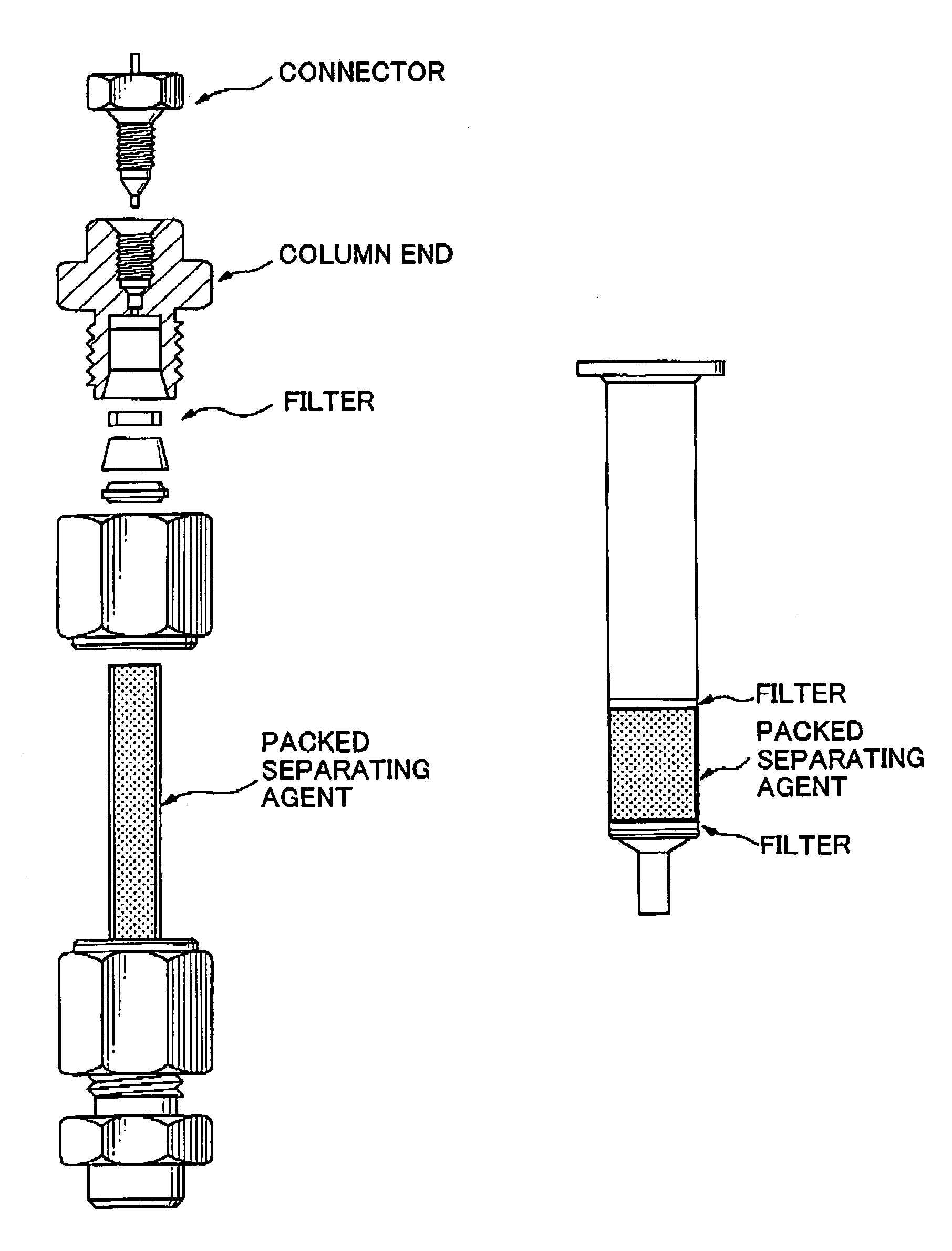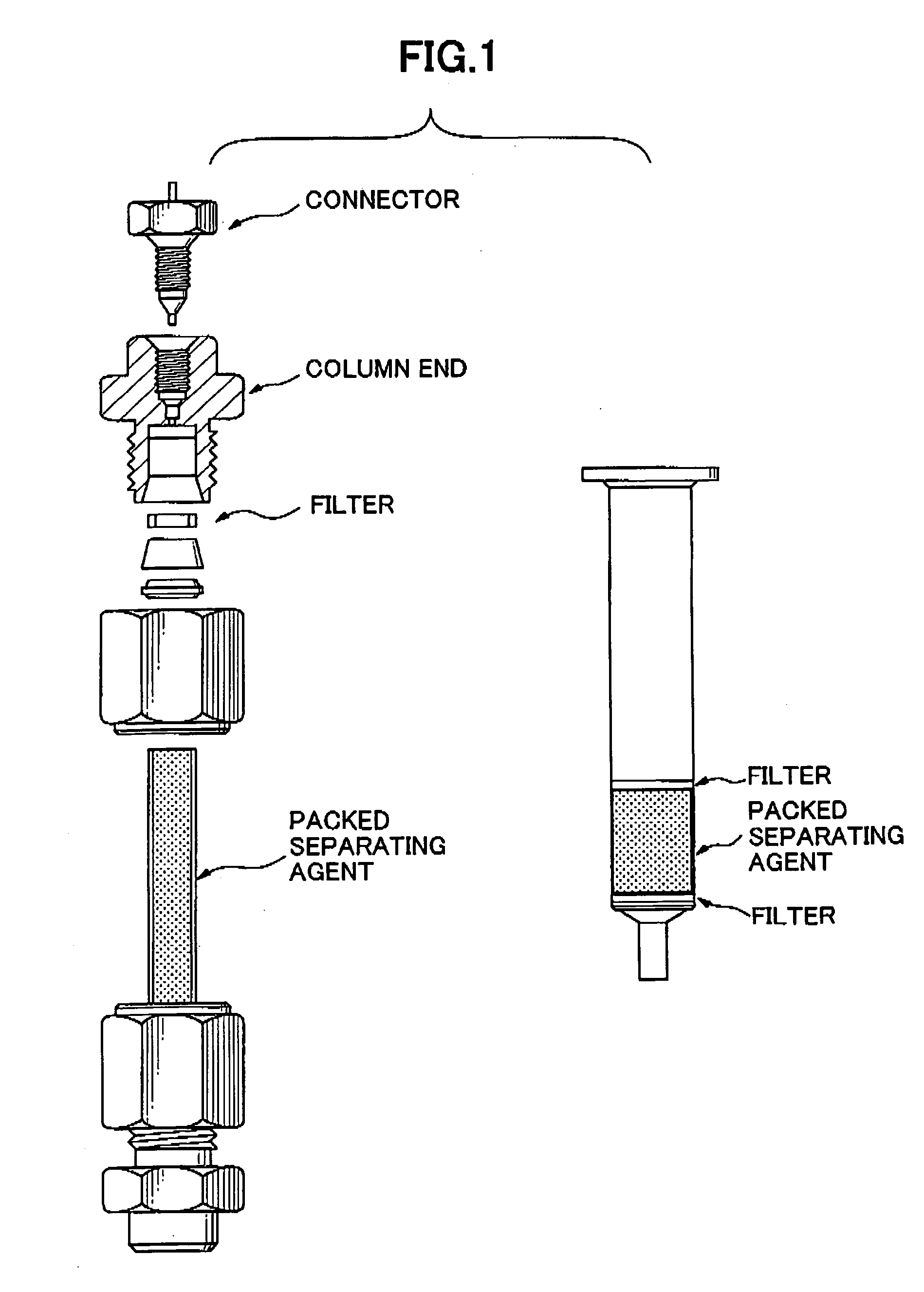Separating agent for solid-phase extraction
a separation agent and solid-phase technology, applied in separation processes, filtration separation, instruments, etc., can solve the problems of insufficient workability, affecting the yield of separating agents suitably used for chromatography, and liable to be quite expensive, so as to achieve excellent workability, improve yield, and improve the effect of workability
- Summary
- Abstract
- Description
- Claims
- Application Information
AI Technical Summary
Benefits of technology
Problems solved by technology
Method used
Image
Examples
example 1
[0071] To a 1 L volume conical flask, there were added 50 g of silica gel having a particle size ranging from 35 to 65 μm (average particle: 50 μm) and 500 mL of a 0.2% (w / v) aqueous solution of hydroxypropyl cellulose (the hydroxypropyl cellulose was purchased from NACALAI TESQUE, INC.), followed by stirring the resulting mixture at 120 rpm and room temperature for 20 hours. After the completion of the agitation, the mixture was washed first with 900 mL of deionized water and then with 100 mL of acetone, followed by drying at 80° C. for 20 hours under reduced pressure to thus give silica gel particles coated with hydroxypropyl cellulose (hereafter referred to as “HPC Silica Gel”).
[0072] To a 4-necked 100 mL volume flask, there were added 2.25 g of divinyl benzene having a purity of 80% (available from Aldrich Chemical Co., Ltd.), 0.75 g of styrene (available from Tokyo Kasei Kogyo Co., Ltd.) and 3 mL of toluene (available from Wako Pure Chemical Industries, Ltd.), followed by the ...
example 2
[0104] To a 1 L volume conical flask, there were added 50 g of silica gel having an average particle size of 50 μm and 600 mL of a 1.0% (w / v) aqueous solution of polyvinyl alcohol (this PVA was a product available from JAPAN VAM & POVAL CO., LTD. and having a degree of saponification ranging from 78.0 to 80.5 mole %), followed by stirring at 120 rpm for not less than 20 hours at room temperature. After the completion of the agitation, the resulting mixture was washed with 1300 mL of deionized water and then with 100 mL of acetone and then dried at 80° C. under reduced pressure to thus give silica gel particles coated with polyvinyl alcohol layer (hereafter referred to as “PVA Silica Gel”). Yield: 87.9% (49.25 g).
[0105] To a 4-necked 100 mL volume flask, there were added 1.0 g of divinyl benzene having a purity of 80% (available from Aldrich Chemical Co., Ltd.), 0.5 g of ethylene glycol di-methacrylate (available from Wako Pure Chemical Industries, Ltd.), 0.5 g of N-vinyl pyrrolidon...
example 3
[0107] To a 1 L volume conica flask, there were added 50 g of silica gel having an average particle size of 50 μm and 600 mL of a 0.2% (w / v) aqueous solution of methyl cellulose (this methyl cellulose was purchased from NACALAI TESQUE, INC.), followed by stirring at 120 rpm for not less than 20 hours at room temperature. After the completion of the agitation, the resulting mixture was washed with 1300 mL of deionized water and then with 100 mL of acetone and then dried at 80° C. under reduced pressure to thus give silica gel particles coated with methyl cellulose layer (hereafter referred to as “MC Silica Gel”). Yield: 89.9% (46.06 g).
[0108] To a 4-necked, 100 mL-volume flask, there were added 1.0 g of divinyl benzene having a purity of 80% (available from Aldrich Chemical Co., Ltd.), 0.5 g of ethylene glycol di-methacrylate (available from Wako Pure Chemical Industries, Ltd.), 0.5 g of N-vinyl pyrrolidone (available from NACALAI TESQUE, INC.) and 2 mL of toluene (available from Wa...
PUM
| Property | Measurement | Unit |
|---|---|---|
| Percent by mass | aaaaa | aaaaa |
| Percent by mass | aaaaa | aaaaa |
| Particle size | aaaaa | aaaaa |
Abstract
Description
Claims
Application Information
 Login to View More
Login to View More - R&D
- Intellectual Property
- Life Sciences
- Materials
- Tech Scout
- Unparalleled Data Quality
- Higher Quality Content
- 60% Fewer Hallucinations
Browse by: Latest US Patents, China's latest patents, Technical Efficacy Thesaurus, Application Domain, Technology Topic, Popular Technical Reports.
© 2025 PatSnap. All rights reserved.Legal|Privacy policy|Modern Slavery Act Transparency Statement|Sitemap|About US| Contact US: help@patsnap.com


